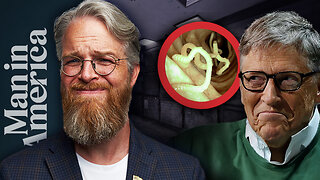Premium Only Content

The Vatican Nativity Scene
Music written and generously provided by Paul Jernberg. Find out more about his work as a composer here: http://pauljernberg.com
Spanish translations by Vélez Translations, http://www.veleztranslations.com
I wanted to find an excuse to give some kind of reflection on the incarnation and what it is that makes Christmas a reason for Christians of all stripes to celebrate and mark the occasion.
Because, this isn’t just a birthday party for a great religious leader. It’s the moment in history in which God performed his great reset.
It’s the moment at which God who created the universe and us within it, revealed to us what could only have otherwise been hoped for – that he is so invested in the human race, that he is so concerned with our fate and the fate of this world, that instead of acting remotely for our benefit, he enters into the story himself. He becomes one of us – the word becomes flesh.
Now this is a staggering exposition of who God is and what his priorities are for a number of reasons, but I want to focus our attention on one aspect of it which is that God used matter or the physical world to reveal himself to us.
Because we are physical beings, it would make sense that the way for us to best encounter him is not just through our minds or our souls, but also through the manner in which we commonly encounter every other person – our physical senses.
We can see the invisible God, we can touch him, we can listen to him, we can embrace him as one of us which is a dramatic progression in potential intimacy with divinity.
And this physical encounter wasn’t just for the people of 1st century Judea. It was to persist through time for every generation.
Now, if you’re a faithful Catholic, you’ll already be familiar with the fact that this physical encounter persists through the sacraments, most profoundly in the eucharist where we experience physical communion and intimacy with Jesus but also in something like reconciliation where we literally hear the words of absolution coming from a priest in persona Christi.
But another way we encounter the incarnation which is less understood and less familiar because of how muddled our understanding is in the modern age, is through sacred art.
Jesus is the icon of the invisible Father. He’s the physical revelation of God. Jesus said, “if you have seen me you’ve seen the father.” (John 14:9)
And this understanding is still nurtured in Eastern Christianity where they understand icons as performing a similar function in God’s saving work through the incarnation of Jesus.
But the key thing to remember is that God’s intention in the incarnation was to reveal himself to us. To make himself more available, more explicit, and more accessible to us in a manner that is typical of our experience – physical reality.
So sacred art, for it to be effective, needs to follow God’s lead in that. If one of its chief purposes is to reveal the icon of God to us, it provides for us a criterion by which we can judge what is good sacred art and what is bad sacred art.
From that, I’d say that good sacred art communicates something definite and explicit to us. It aims to apprehend a true icon of God or of the story of salvation and accurately render it for us in a way that will encourage our understanding… not discourage or confuse that understanding.
God’s intention, in salvation has been to reveal himself to us – that’s what revelation means. But the trend in modern art is to be ambiguous about what the true meaning of the art is.
I watched a video on YouTube recently in which Steve Martin, for some reason, was supposed to be explaining how to interpret modern art. But what he actually did in the video was say a bunch of confusing things about a piece of art while constantly correcting himself by saying you can’t actually interpret it.
So the whole time while he was saying things, he was really only pretending that he might have an insight and then in the end, conceding that you can’t do that and that all interpretations are valid and invalid. In other words, the whole exercise is a pretense in meaning or, perhaps a more appropriate word would be pretentious.
A more classical understanding of the purpose of art was that an artist’s job is to capture a vision of something real that is rare or hard to understand and then portray it to their audience in such a way that they might also be able to capture that vision.
The object of art, in this case, is something outside the artist, something true and real that is part of the fabric of reality.
Read the whole transcript at https://brianholdsworth.ca
-
 11:57
11:57
Brian Holdsworth
1 year ago $0.09 earnedWhat Should Catholics Do?
4612 -
 LIVE
LIVE
Wendy Bell Radio
4 hours agoPet Talk With The Pet Doc
3,977 watching -
![Mr & Mrs X - [DS] Trafficking Empire – The Pedo Network Island, The Cover-Up: Part 2 - Ep 6](https://1a-1791.com/video/fww1/f8/s8/1/y/p/x/f/ypxfz.0kob-small-Mr-and-Mrs-X-DS-Trafficking.jpg) LIVE
LIVE
X22 Report
15 hours agoMr & Mrs X - [DS] Trafficking Empire – The Pedo Network Island, The Cover-Up: Part 2 - Ep 6
389 watching -
 27:15
27:15
Liberty Hangout
2 days agoThe Most DELUSIONAL Democrats on Earth!
5.56K83 -
 13:13
13:13
Mrgunsngear
15 hours ago $1.95 earnedStreamlight TLR-1 HP Review: Can It Dethrone Surefire?
13.7K8 -
 38:41
38:41
JohnXSantos
22 hours agoHow To Start A CLOTHING BRAND on a BUDGET! Step X Step (2025)
41 -
 1:26:34
1:26:34
Man in America
18 hours agoExposing the Cover-Up That Could Collapse Big Medicine: Parasites
64.8K57 -
 30:57
30:57
Her Patriot Voice
15 hours ago $13.09 earnedDemocrats More Unhinged Than EVER Before!
86K121 -
 29:13
29:13
Clownfish TV
23 hours agoGen Z are Becoming the Boomers?! | Clownfish TV
9.25K34 -
 1:48:31
1:48:31
Squaring The Circle, A Randall Carlson Podcast
18 hours agoMEGA Tsunamis and the formation of our World ft. Dr. Dallas Abbot
22.8K5